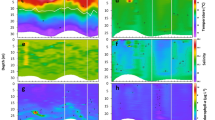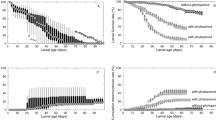Abstract
Larvae of several species of invertebrates that live just below the surface of the seabed (infaunal species) are known to make active and consistent choices among sedimentary habitats; generally they choose the sediments most similar to those occurring in the habitats where the adult stages live in the field1–5. But, previous experiments designed to investigate habitat selection by such larvae were con-ducted almost entirely in still water and never under realistic flow conditions. Therefore, although larvae are able to actively select settlement sites, it is not known whether these choices are exercised in natural field flows5. We report here that the larvae of the infaunal polychaete, Capitella sp. I and the infaunal bivalve Mercenaria mercenaria, actively choose appropriate substrates in still water, but the species differ in their selection capabilities under controlled, realistic and defined flow conditions in the laboratory.
This is a preview of subscription content, access via your institution
Access options
Subscribe to this journal
Receive 51 print issues and online access
$199.00 per year
only $3.90 per issue
Buy this article
- Purchase on Springer Link
- Instant access to full article PDF
Prices may be subject to local taxes which are calculated during checkout
Similar content being viewed by others
References
Meadows, P. S. & Campbell, J. I. Adv. mar. Biol. 10, 271–382 (1972).
Scheltema, R. S. Thalassia jugosl. 10, 263–296 (1974).
Strathmann, R. R. in Settlement and Metamorphosis of Marine Invertebrate Larvae (eds Chia, F. S. & Rice, M. E.) 235–246 (Elsevier, New York, 1978).
Woodin, S.A. Bull. mar. Sci. 39, 401–407 (1986).
Butman, C. A. Oceanogr. mar. Biol. A. Rev. 25, 113–165 (1987).
Grassle, J. P. & Grassle, J. F. Science 192, 567–569 (1976).
Grassle, J. F. & Grassle, J. P. in Life Histories and Genetic Variation in Marine Invertebrates (eds Battaglia, B. & Beardmore, J.) 347–364 (Plenum, New York, 1978).
Sanders, H. L. et al. J. mar. Res. 38, 265–380 (1980).
Dubilier, N. Biol. Bull. 171, 479 (1986).
Dubilier, N. Biol. Bull. 174, 30–38 (1988).
Pratt, D. M. J. mar. Res. 12, 60–74 (1953).
Wells, H. W. Ecology 38, 123–128 (1957).
Peterson, C. H., Summerson, H. C. & Duncan, P. B. J. mar. Res. 42, 123–138 (1984).
Gross, T. F. & Nowell, A. R. M. Cont. Shelf Res. 2, 109–206 (1983).
Butman, C. A. in Marine Interfaces Ecohydrodynamics (ed. Nihoul, J. C. J.) 487–514 (Elsevier, Amsterdam, 1986).
Butman, C. A., Grassle, J. P. & E. J. Buskey (Ophelia, in the press).
Carriker, M. R. J. Elisha Mitchell Sci. Soc. 77, 168–241 (1961).
Author information
Authors and Affiliations
Rights and permissions
About this article
Cite this article
Butman, C., Grassle, J. & Webb, C. Substrate choices made by marine larvae settling in still water and in a flume flow. Nature 333, 771–773 (1988). https://doi.org/10.1038/333771a0
Received:
Accepted:
Issue Date:
DOI: https://doi.org/10.1038/333771a0
This article is cited by
-
Jumping Spiders (Habronattus clypeatus) Exhibit Substrate Preferences that Partially Maximize Vibration Transmission Efficiency
Journal of Insect Behavior (2021)
-
The significance of refuge heterogeneity for lowland stream caddisfly larvae to escape from drift
Scientific Reports (2019)
-
Testing for Sediment Acidification Effects on Within-Season Variability in Juvenile Soft-Shell Clam (Mya arenaria) Abundance on the Northern Shore of the Bay of Fundy
Estuaries and Coasts (2018)
-
Trophic versus structural effects of a marine foundation species, giant kelp (Macrocystis pyrifera)
Oecologia (2015)
-
Effect of background substrate on recruitment of benthic marine invertebrates to subtidal cobble-filled collectors
Marine Biology (2015)
Comments
By submitting a comment you agree to abide by our Terms and Community Guidelines. If you find something abusive or that does not comply with our terms or guidelines please flag it as inappropriate.



